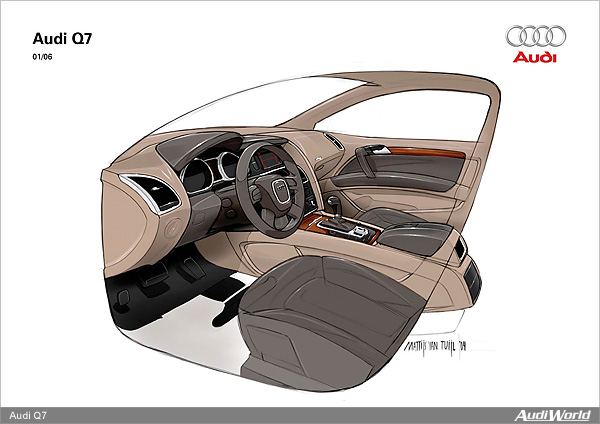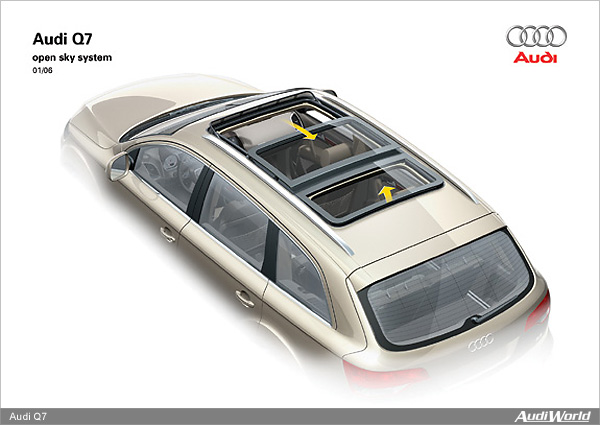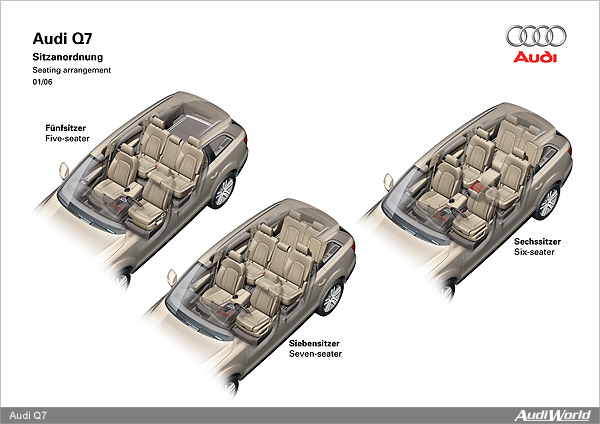The Audi Q7: Interior

Interior Elegant and extremely versatile The interior of the Audi Q7 is sporty and at the same time elegantly functional. The uncompromising quality standards of the brand are to be found once again in the Audi Q7 performance SUV, combined with a level of practicality and versatility that sets standards. Clear architecture and the finest materials and craftsmanship throughout: these are the lasting impressions conveyed by the interior of the Audi Q7. The elegant forms and the high-quality surfaces are both robust and luxurious. The instrument panel is covered as standard in a soft, so-called slush skin, pleasing to the eye and to the touch; typically for Audi, the gaps are exceptionally even and narrow. In respect of the visual impression, calm surfaces in the same material and colour dominate, accommodating the functional units which are embedded like islands. Inlays in aluminium and three fine woods The elegant impression is enhanced by the optional inlays. They are available either in Aluminium Marlin silver or in one of the three fine wood options burr walnut, olive ash and tamo a dark wood from Japan. Air outlets, optionally in aluminium look, aluminium inlays in the wood trims, discreet decorative rings and strips on covers and switches, as well as an exquisitely designed lighting package including footwell lights using LED technology, can be ordered if desired to add yet more finesse to the ambience. Additional options including Alcantara trim for the headlining and roof pillars as well as various leather trims complete the overall impression of elegance and style. The heavily grained Cricket leather, the sumptuous quality of Verano and the standard Cosmo cloth are available for selection. The electrically adjustable sports seats can be ordered in Verano leather or in a combination of Alcantara and leather. As well as the basic version, Audi Q7 customers can choose one of five design packages with seats, seat covers, carpet, floor mats, inlays and air vent trims all designed to match perfectly. The leather package comes as standard for the Cockpit based on the Audi A6 The interior architecture reveals the Audi Q7s kinship with the Audi A6 and A8 saloons. Powerful taut lines lend the door trims a dynamic look. The styling of the controls and cockpit, with its generous layout and sleek design, was inspired by the Audi A6. The centre console is organically integrated into the cockpit; the main instruments speedometer and rev counter feature dropped-shaped surrounds. The broad and high centre tunnel is also a perfectly uncluttered and functional operating area, undisturbed by the presence of a handbrake instead there is a foot-operated parking brake. The MMI Multi Media Interface located on the tunnel is highly impressive for its ergonomic qualities. Independent comparative tests have once again underscored the superiority of this Audi technology, even compared with new designs from the competition. The MMI basic version with a monochrome display is standard and can be extended in two stages. The first version features the addition of a sound system with eleven speakers and a total output of 180 watts, the second version a double tuner and colour display. Bose sound system with 14 speakers Other modules include a Bose surround sound system with a digital sound processor and 14 speakers together with a large subwoofer, a digital audio tuner, an analogue/digital TV tuner and two different navigation systems with CD and DVD drives. A car telephone, a mobile phone preparation with Bluetooth interface and a speech dialogue system to simplify system operation are further technologies that ensure luxurious and relaxed travel. Even the standard operating system comes with an audio system featuring eight speakers and a single CD drive. The standard specification for the Audi Q7 also includes a sensor package with light/rain sensor, automatic headlight activation and a coming/leaving home lighting function. In addition, the Audi Q7 4.2 FSI has a number of top-class features on board: the driver information system, cruise control and a leather-covered multifunction steering wheel, which the driver can use to operate the audio system, the MMI and optionally the speech input system and phone. Indirect air supply for automatic air conditioning The deluxe automatic air conditioning, which comes as standard, is exceptionally quiet and almost completely draught-free. Its special feature is an air outlet grille in the centre of the instrument panel that ensures indirect ventilation. The air flow and temperature can be adjusted separately for the drivers and front passengers sides. The automatic control operates based on the angle of the sun; an air purity sensor activates the air recirculation function if necessary. As an option, Audi supplies the Q7 with a four-zone automatic air conditioning system, which provides even more cooling and heating power and even more precise air-flow regulation. The four-zone system has a separate air conditioner unit in the left side panel of the luggage compartment and a separate operating panel for the rear passengers. This air conditioning system comprises ten sensors, which register the temperature in the passenger compartment, additional air outlets in the C-pillars and a total of 19 electric motors. All Audi Q7 models are equipped with an electric auxiliary water pump, which at the push of a button utilises the residual heat from the coolant to adjust the temperature of the interior. The Audi Q7 3.0 TDI also has an auxiliary heater on board with an output of 5 kW. The optional auxiliary heating including auxiliary ventilation can be activated by remote control, via the MMI or with a timer.
open sky system panorama sunroof over 170 cm long The large-area panorama sunroof, known as the open sky system, is a very special extra for the performance SUV. It creates a light-flooded sense of spaciousness and a fresh and airy interior for a rewarding driving experience. The open sky system is around 1,700 millimetres long and comprises three glass elements. The front section can be tilted electrically by means of a rotary switch or opened by 490 millimetres; the rear section is tilted. Two slightly transparent roller blinds the front blind electric, the rear operated by hand prevent the interior from overheating. The Audi Q7s panorama sunroof generates very little noise when open. A mesh wind deflector reduces noise levels and draughts. Heated wipers The wiper motors are further evidence of how well thought-out the controls in the Audi Q7 really are: they reverse electronically the wipers direction of rotation. The right arm also executes an additional lifting movement to provide the widest possible field of clear vision. In the rest position both wiper arms are invisible to the driver, lying in the slipstream of the engine compartment lid where they cannot produce any unpleasant air flow noise. To prevent the rubber lips from deteriorating, the wiper blades are placed in a different direction after each use. At temperatures of below 4 degrees the motor lifts the wipers slightly in this way they are heated by the air vents in the interior and do not become frozen to the windscreen. Numerous storage compartments enhance travelling comfort for every passenger. Brackets suitable for 1.5-litre bottles will be found in all four door pockets; there are also six cup holders. Additional stowage areas are incorporated in the centre console and the centre armrest. Nets are to be found in the footwell on the front passenger side, on the luggage compartment trim and on the back of the front seats; a compartment for glasses, for example, is integrated in the roof module. As an option, Audi Q7 customers can order a spacious deluxe centre armrest with separate sections for the driver and front passenger. Completely new seating system The seats in the Audi Q7 have been redesigned from scratch and provide excellent comfort on long journeys and a relaxed seated position throughout. The drivers seat is height-adjustable and the steering column can be adjusted for height and angle. The prospective customer can generally choose between three seat configurations: the performance SUV is available as a 5-seater, 7-seater or The standard Audi Q7 will leave the assembly line as a 5-seater. In this case the seat bench in the second row is divided 60 : 40; as an option both elements can be moved back by 100 millimetres in this way passengers can enjoy the most generous legroom in this vehicle category. The rear seat split is 40 : 20 : 40; an armrest with pop-up cup holders is corporated in the centre section. This element can be folded down completely to create a through-loading width of If all three backrests are folded down it is not necessary to remove the head restraints a flat loading area is created, flush with the level of the luggage compartment. For even greater seating comfort, all backrests in the second row of seats can be tilted by 10 degrees. The 7-seat version has two seats in the third row suitable for persons of up to 1.6 metres tall. They can be folded flat on the loading floor if necessary. The mechanism for this is particularly user-friendly by pushing the backrests (divided 50 : 50) slightly, the head restraints are retracted automatically. Cup holders are integrated in the luggage compartment side trim panels. Convenient access thanks to easy entry The seats in the second row of a 7-seater Audi Q7 are adjustable for fore/aft movement as standard. They are equipped with a new and convenient adjustment mechanism for carefree access to the rear: if the backrests are folded forward by an angle of around 50 degrees, the entire seat slides forward by around On the 6-seater Audi Q7, the individual fore/aft adjustable seats in the second row have a particularly comfortable design, based on the sports seats. The thigh support has more padding, is broader and longer, and has slightly higher side sections. At shoulder level the backrests are wider and softer. Between the comfort seats there is a separate centre console with two cup holders and a large storage compartment as well as a folding armrest. To supplement the range of functions for the second row of seats, the Audi Q7 can be fitted on request with folding tables on the backs of the front seats and manually operated roller sunblinds at the rear doors and tailgate. Tinted glass is available to prevent the interior from heating up and can be ordered optionally as sound-insulating double-glazing. Isofix attachments for child seats are standard in the second row and in the optional third row. They can be added as an option to the front passenger seat. In this case the front passenger airbag can be deactivated and instead of a mechanical feature an electric function locks the rear doors to prevent them from being opened inadvertently.
Up to 28 configurations The functional seating concept of the Audi Q7 allows up to 28 different loading configurations. The maximum load volume is an ample 2,035 litres, without the seats having to be removed. As a 5-seater the Audi Q7 has a standard luggage area of 775 litres the best in its class. Even if all three seat rows are used, a very respectable luggage capacity of 330 litres remains. The innovative styling of the tailgate its handle released electrically provides exceptionally large access to the load area: it is no less than 1,221 mm wide. As an option and standard on the Audi Q7 4.2 FSI the tailgate can be fitted with electric motors, which are activated by a switch in the drivers door, the remote control and via buttons on the tailgate itself. Two transversally mounted motors in the vehicle operate via a bracket directly at the hinges. A programming function allows the driver to determine the upper end position of the tailgate according to his preference. With the adaptive air suspension option, loading is even more convenient: the rear is lowered by 71 millimetres at the touch of a button, lowering the loading sill to 765 millimetres. 116-centimetre-wide through-loading facility Standard on the Audi Q7 is a robust loading sill made of high-grade steel, which seamlessly joins the loading floor. The through-loading facility is an impressive 1159 mm wide, sufficient for large golf bags. A luggage compartment cover, which can be conveniently operated with one hand, is also part of the standard package; with two additional roller covers, it compensates for the various positions of the backrests in the second seat row. Standard lashing eyes hold retaining straps or ropes. A load guard and roof rails are also provided as standard. A full-size 18-inch spare wheel or a space-saving spare wheel are available for the performance SUV as options. A tyre sealant is supplied as standard by Audi. Sufficient space remains above in the double load-area floor to accommodate a removable, waterproof dirt-resistant tray. This can be used for soiled or wet items such as ski boots and for all types of small utensils. On the 5-seater there is an additional large storage compartment behind the second seat row. Rails and a variable storage box Customers who are particularly sporty and active can order the Audi Q7 with various practical features. These include a removable bag for up to four pairs of skis or two snowboards, a reversible mat for the luggage compartment that also protects the loading sill and a rail system with adjustable lashing eyes, telescopic rods and straps, similar to the Audi A6 Avant. At a later date the rails will also be enhanced by a storage box that utilises the entire width of the luggage compartment. It can be loaded from the interior through the folded centre armrest and tilted by 90 degrees it then serves as a practical stowage facility for items of shopping. Another useful convenience feature is the trailer tow hitch on the Q7. It is available as an option with electrical operation, which is swung in and out via a button in the load area. It would even be possible to hitch a good-sized boat to the 4.2 FSI and the 3.0 TDI they can each tow a weight of 3.5 tonnes braked and 750 kg unbraked. And with the high nose weights and roof loads (140 and 100 kg respectively) they should be well-prepared for any situation. |


